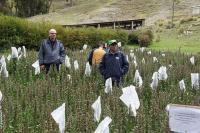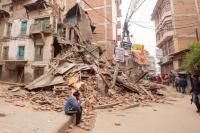-
New analysis reveals large-scale motion around San Andreas Fault System
An array of GPS instruments near the San Andreas Fault System in Southern California detects constant motion of Earth’s crust — sometimes large, sudden motion during an earthquake and often subtle, creeping motion. The researchers discovered nearly 125 mile-wide “lobes” of uplift and subsidence — a few millimeters of motion each year — straddling the fault system. This large scale motion was previously predicted in models but until now had not been documented.
-
-
Waterworld: Learning to live with flooding
Flash floods, burst riverbanks, overflowing drains, contaminants leaching into waterways: some of the disruptive, damaging, and hazardous consequences of having too much rain. But can cities be designed and adapted to live more flexibly with water – to treat it as friend rather than foe?
-
-
Thirty-one leading scientific societies call for action on climate change
In a consensus letter to U.S. policymakers, a partnership of thirty-one leading nonpartisan scientific societies the other day reaffirmed the reality of human-caused climate change, noting that greenhouse gas emissions “must be substantially reduced” to minimize negative impacts on the global economy, natural resources, and human health. Climate-change impacts in the United States have already included increased threats of extreme weather events, sea-level rise, water scarcity, heat waves, wildfires, and disturbances to ecosystems and animals, the intersociety group reported.
-
-
Looking for ways to predict response to hurricane evacuation orders
Millions of people will likely be in harm’s way as a new hurricane season unfolds in the United States. The National Oceanic and Atmospheric Administration predicts up to eight hurricanes in the 2016 season, and as many as four major storms with winds of 111 miles per hour or more. What people do – or do not do – to get out of harm’s way is of keen interest to disaster and emergency response officials. Plans and contingencies work best when they are based on reliable predictions.
-
-
Climate assessment must be relevant and useful to policymakers
Climate change assessments must be more relevant to policymakers’ needs, experts say. They argue that coming off the Paris agreement late last year, ambition for fighting climate change is high. They assert that groups like the Intergovernmental Panel on Climate Change (IPCC) should capitalize on this increased enthusiasm by integrating studies and presenting their results in ways that are useful to policymakers.
-
-
We need better information to understand extreme weather
Scientists need more credible and relevant information to help communities become more resilient to extreme weather events such as floods. Researchers need improved techniques to be able to understand why the climate is changing, and the part humans play in this process, experts say.
-
-
Crop breeding is not keeping pace with climate change

Crop yields will fall within the next decade due to climate change unless immediate action is taken to speed up the introduction of new and improved varieties, experts have warned. The researchers focused on maize in Africa but the underlying processes affect crops across the tropics.
-
-
Datacasting helps first responders with live video streaming via smartphone

When torrential storms caused widespread flooding in Houston, Texas, in mid-April, first responders needed a way securely to share information amongst their many organizations. Luckily the DHS S&T First Responders Group’s (FRG) datacasting system was available. Datacasting provides public safety users with the capability to transmit secure video and data over existing broadcast television signals to a targeted audience. Even in an emergency situation, where other wireless services often fail due to network congestion, datacasting still provides a reliable platform to quickly send large files.
-
-
The contribution of human dynamics to coastal communities’ resilience
The National Academies of Sciences has established a $10 million grants program to fund projects that enhance the science and practice of coastal community resilience in the Gulf of Mexico region. Rather than focus on infrastructure needs or the built environment, as many existing resilience-focused programs do, the new grants program will support the study of the human dynamics that influence a community’s ability to respond to adverse events.
-
-
Better understanding – and forecasting -- of earthquakes

Researchers have broken new ground in understanding the complexity of earthquakes and the possibility to forecast them. The researchers used GPS records of surface motion to map the 7.8 magnitude Gorkha earthquake, which broke a 150-kilometer section of the Himalayas in April 2015, terminating close to Kathmandu.
-
-
Western U.S. braces for “dangerous and deadly” 120 degrees heatwave

Forecasters have warned that temperatures in the western United States are set to reach 120 degrees in a “rare, dangerous, and deadly” heatwave. The forecasts have worried officials, who are bracing for devastating wildfires and power cuts which will knock out air-conditioning systems, leading to heat-related fatalities. The area which will be subjected to the heat wave stretches from Oklahoma to California. It is home to sixty-six million people, one-fifth of the U.S. population.
-
-
Year-long heat streak results in new global heat records
Fresh out of the oven that was a warm start to the year, global temperatures are on a roll: For the 13th consecutive month, the globe was record warm in May — the longest such stretch in 137 years of record-keeping. The more than yearlong heat streak also resulted in other new global heat records.
-
-
Future summers could regularly be hotter than the hottest summers on record
In fifty years, summers across most of the globe could regularly be hotter than any summer experienced so far by people alive today, according to a new study. If climate change continues on its current trajectory, the probability that any summer between 2061 and 2080 will be warmer than the hottest on record is 80 percent across the world’s land areas, excluding Antarctica, which was not studied. If greenhouse gas emissions are reduced, however, that probability drops to 41 percent, according to the study.
-
-
Danger from extreme storms, high seas on the rise
Storms that battered Australia’s east coast are a harbinger of things to come and a stark reminder of the need for a national effort to monitor the growing threat from climate change, researchers warn. “The damage we’ve seen is a harbinger of what’s to come,” said one expert. “Climate change is not only raising the oceans and threatening foreshores, but making our coastlines much more vulnerable to storm damage. What are king high tides today will be the norm within decades.”
-
-
France unveils app to alert people to terror attacks
Euro 2016 soccer tournament begins on Friday, and as part of the massive security operation undertaken to secure the ten millions spectators who will be watching the games from 10 June to 10 July, the French government has created a smartphone app designed to send warnings directly to people’s phones in the event of a bombing, shooting, or other disaster.
-
More headlines
The long view
The Surprising Reasons Floods and Other Disasters Are Deadlier at Night
It’s not just that it’s dark and people are asleep. Urban sprawl, confirmation bias, and other factors can play a role.
Why Flash Flood Warnings Will Continue to Go Unheeded
Experts say local education and community support are key to conveying risk.
